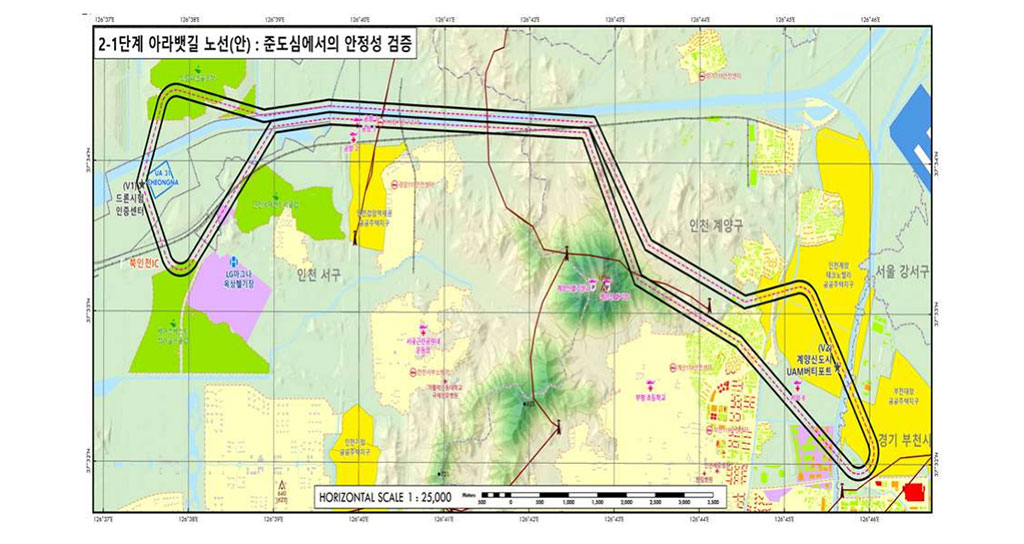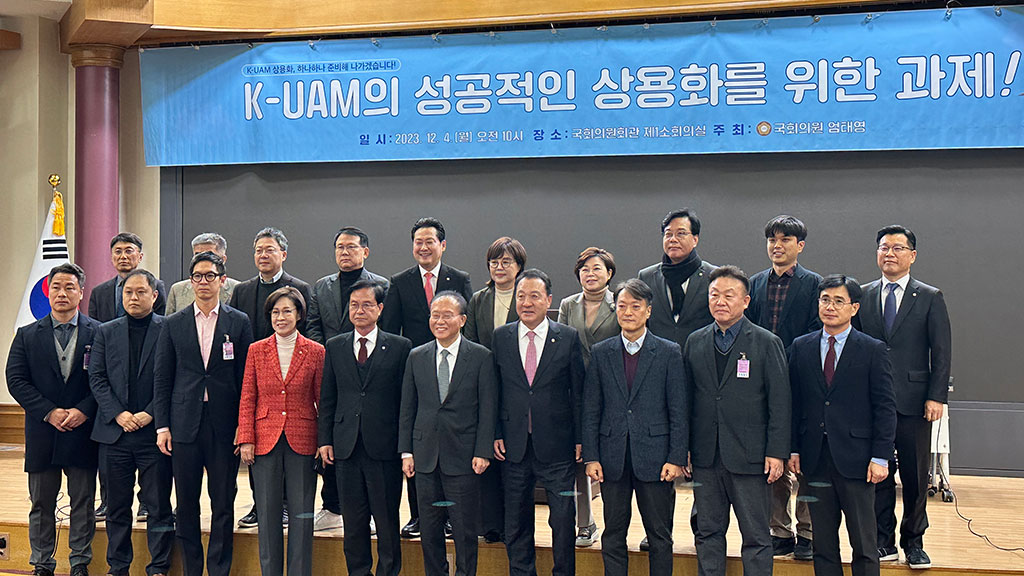국민의힘 엄태영 의원, 최춘식 의원이 4일 국회에서 공동 개최한 K-UAM 상용화 토론회에서 국토교통부 도심항공교통정책과 최승욱 과장은 규제특례가 주어지는 ‘도심항공교통법’을 기반으로 K-UAM 정책 방향을 논의했다. 국토부 최승욱 과장은 “UAM법과 제도는 기존 항공사법과 다른 신산업에 걸맞게 제정하는 것이 목표”며, “지난 10월 통과된 UAM법을 기반으로 초기 사업자의 부담을 줄이는 방향으로 협의를 해나가고 있다”고 말했다. 정부는 지난 8월 실증 및 시범사업을 위해 각종 규제특례를 골자로 한 법안을 발의했다. 도심항공교통법은 지난 10월 본회의를 통과 후 내년 4월부터 시행될 예정이다.
▲4일 국회에서 K-UAM 상용화 토론회가 개최됐다
국토부, UAM 규제특례 초기 사업자 부담 낮춰
UAM 규제특례 포함한 UAM법 내년 4월 시행
정부가 국내 UAM(도심항공교통) 사업자들의 초기 투자 부담을 줄여주기 위해 공공 수요 지원 방안을 확대할 계획을 내비쳤다.
국민의힘 엄태영 의원, 최춘식 의원이 4일 국회에서 공동 개최한 K-UAM 상용화 토론회에서 국토교통부 도심항공교통정책과 최승욱 과장은 규제특례가 주어지는 ‘도심항공교통법’을 기반으로 K-UAM 정책 방향을 논의했다.
■ “UAM법, 기존 항공사법과 차별화”
UAM은 첨단 산업의 집약체인 만큼 기체, 버티포트, 통신, 운용 시스템 등 관련 분야에서의 거대한 시장을 준비하기 위한 제반 작업이 필요하나, 아직 미비한 법과 규제 때문에 많은 부분이 과제로 남아있다.
국토부 최승욱 과장은 “UAM법과 제도는 기존 항공사법과 다른 신산업에 걸맞게 제정하는 것이 목표”며, “지난 10월 통과된 UAM법을 기반으로 초기 사업자의 부담을 줄이는 방향으로 협의를 해나가고 있다”고 말했다.
이날 SKT를 비롯한 컨소시엄 참여 기관들은 초기 사업자에 대한 지원을 강력하게 요구했다. 이를 위해 공공 수요 또는 관광 수요를 견인할 수 있는 행정 및 재정적 지원이 필요하다고 주장했다.
SKT 신용식 부사장은 “민간 사업자 입장에서 특별법 통과는 다행스럽지만, 그랜드챌린지에 막대한 비용을 투자하고 있어 불확실성을 제거하기 위해 빠르고 구체적으로 하위 법령들도 정리되길 바란다”고 말했다.
SKT는 UAM의 주요 수요처로 교통의 수단뿐만 아니라 공공 서비스 및 관광, 물류 분야에서의 활용을 들었다. 그러나 UAM이 실질적인 교통 수요를 흡수하며 상용화 되기까지는 시간이 걸릴 것으로 예측했다.
카카오모빌리티 장성욱 부사장은 성공적인 UAM 서비스 확립을 위해 기존 기상 교통수단 및 인프라와의 연계를 강조했다. 예컨대 “수상 택시가 밀접한 서비스가 되지 못했던 중요한 이유는 결국 시작과 끝단에 있는 다른 교통수단과의 연계가 다소 미흡했기 때문”이라고 설명했다.
또한 카카오모빌리티는 산림청, 소방청, 도로교통공사 등과 공공 영역에서 먼저 도입해 활용성을 극대화하고, 도심 수용성을 키우는 방안을 제시했다. 이와 함께 버티포트 고객 신분 인증, 보안 프로세스가 간소화, 가격적인 측면에서 탄력적인 요금 운영 등 민간에게 높은 자유도를 부여하는 방안을 주장했다.
국토부는 기재부를 비롯한 관련 부처와 행정 및 재정 지원으로 협의해 법 제도를 검토를 하고 있는 것으로 나타났다. 국토부 최 과장은 “공공 사업에서 우선적으로 수요를 창출할 목적으로 안정적인 운영비 확보에 나설 계획”이며, “내년쯤에는 관련 부처들과 어떤 형태로든 방안을 마련할 준비를 하고 있다”고 말했다.
주요 내용은 버티포트 설립 시 건축물 인센티브를 제공해 민간 중심 시장 형성을 유도하는 방식의 당근책이 예측된다. 최 과장은 “제도 자체를 민간 중심으로 맞춰서 안전과 결부되지 않는 선에서 정부는 얼마든지 기업의 의견을 수용할 생각이 기본적으로 있다”고 덧붙였다.
■ UAM법, 2024년 4월 25일부터 시행

▲UAM 수도권 실증노선 항공지도
K-UAM은 초기 상용화를 2025년을 목표하는 가운데, 국내 여건에 맞는 UAM 운용 개념 및 기술 기준이 시급한 상황이다. 우리나라는 정부 차원의 민관 협동 실증사업으로 K-UAM 그랜드챌린지가 추진되고 있다.
2025년 수도권 중심의 초창기부터 2035년 전국 확대되는 성숙기까지의 로드맵에 따라 각 기업들은 컨소시엄을 구성했다. 지난 11월 전남 고흥에서의 비행시연이 진행됐고, 2024년 수도권에서의 실증이 예정돼 있다.
정부는 지난 8월 실증 및 시범사업을 위해 각종 규제특례를 골자로 한 법안을 발의했다. 도심항공교통법은 지난 10월 본회의를 통과 후 내년 4월부터 시행될 예정이다. 여기에는 주요 신규 개념을 정의하고, 실증사업구역 및 실증사업자, 시범운용구역에 대한 내용이 포함된다.
UAM법은 과감한 규제특례 입법을 통해 기존 항공 법령을 따르는 경우 신기술 개발 및 검증 시 발생하는 제약을 최소화하는 법적 근거를 마련했다는 데 의의가 있다.
UAM 활용 촉진을 위한 규제특례에 따라 실증사업구역과 시범운용구역에서 안전에 필요한 최소한의 규제를 제외한 기존 항공 관련 법령의 적용이 배제된다.
규제특례를 바탕으로 실증 단계에서의 도심형 항공기 등록 및 인증, 공역, 비행절차 관련 논의가 진행되며, 이는 내년 수도권에서 예정된 준도심, 도심 실증에 영향을 미칠 것으로 예측된다. UAM 초기 사업자는 이를 적극 활용하고 정부의 실증사업에 적극 참여함으로써 UAM 사업자로 우선 지정 받기 위해 유리해질 것으로 기대된다.

